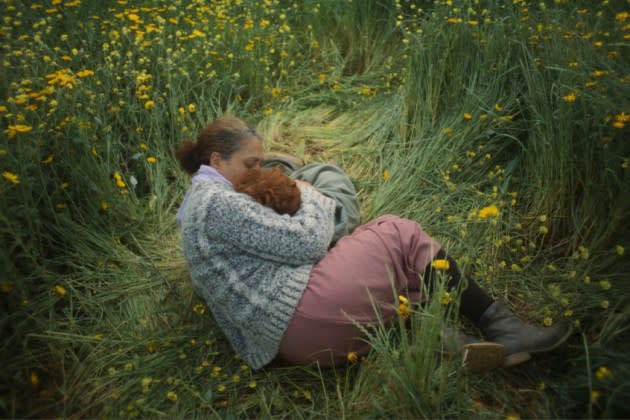‘Who Do I Belong To’ Review: Tunisian-American Director Meryam Joobeur Makes a Handsomely Crafted Debut
- Oops!Something went wrong.Please try again later.
- Oops!Something went wrong.Please try again later.

Aïcha (Salha Nasraoui) and her husband Brahim (Mohamed Hassine Grayaa) live on a farm in northern Tunisia. It’s a modern rural environment of goats, trucks, home cooking and tight-knit families. In Meryam Joobeur’s feature-length debut “Who Do I Belong To,” an early sequence of Aïcha shaving Brahim’s face — an act of intimacy and trust — introduces a key part of the director’s aesthetic strategy: DP Vincent Gonneville’s frequent use of extreme close-ups on the actors’ faces. At times, the camera hovers so close that they almost stop looking like faces at all; there’s a landscape quality to facial features observed from this kind of intense proximity. In the shaving scene, Grayaa’s cheeks, lathered with shaving foam, call to mind mountains buried under drifts of snow.
You might expect from this introduction that Brahim, this monumental patriarch, will play a bigger part in the subsequently unfolding events, and it’s true that when angered, he makes his presence felt. Similarly, when his missing son Mehdi (Malek Mechergui) returns from an ill-fated attempt to fight for ISIS in Syria, accompanied by a silent, pregnant wife in a niqab, it initially feels like Mehdi’s story will dominate the narrative. But the film is more slippery and subtle than that. While the male characters might make more noise, Joobeur aims to prove the adage that still waters run deep, and it is the women who emerge as the soul of her film.
More from Variety
Dea Liane plays Reem, Mehdi’s mysterious new wife, as a magnificent counterargument to anyone who might have thought it difficult to give an arresting performance with a mostly covered face and hardly any dialogue. Her eyes, framed for the majority of her screentime by her niqab, are extraordinary, telegraphing worlds of emotion, running the gamut from trauma and vulnerability to something more sinister. The intensity of her gaze would feel almost supernatural, even if this were not a film with magical realist aspects.
These elements are largely the realm of matriarch Aïcha — played by Nasraoui with moving stoicism — whose powerful subconscious threatens to spill over into the waking world. At times, it’s hard to tell if we’re in a dreamlike sequence that nevertheless reflects reality, or whether we’re inhabiting Aïcha’s actual dreams. It’s a deliberately destabilizing strategy that has the effect of undermining our reliance on empirical truth in favour of something woozier and more intuitive. “Who Do I Belong To” is a film to be watched receptively, though this makes its scenes of violence harder to process when they occur. Joobeur demands that you let your guard down, then sucker-punches you for your troubles.
A particularly hard-to-watch sequence reveals how Reem and Mehdi actually met, while the latter was serving with ISIS. His fellow soldiers’ grim sense that that their actions are righteous is an example of the thinking that has led to some of humanity’s darkest moments, and underlines the sentiment, never far from the surface in this film, that the world is a tough place which heaps iniquity on the weak — and is hardly any more sustaining or enlightening for the strong. Despite this, there’s a rough-hewn beauty to much of the earthy image-making, with Gonneville’s distinctive camerawork matched by lighting and location teams.
That Joobeur’s debut has auspiciously secured her a spot in the Berlinale Competition should assist sales and distribution, though commercial prospects may be limited by the downbeat subject matter and lack of marquee names. The actors are a mixture of professionals and newcomers, and there’s a notable backstory to the casting of the family’s brothers Mehdi, Adam (Rayen Mechergui) and Amine (Chaker Mechergui).
Malek and Chaker were originally cast in Joobeur’s Oscar-nominated 2018 short “Brotherhood” about a year after she first photographed them in Tunisia, herding their father’s sheep. She not only went back to find them when she came to make the short, but also remained faithful to her original casting impulse when expanding the short to feature length — with the film now folding their younger brother Rayen into the mix, further lending an authentic family dynamic to proceedings.
Best of Variety
Sign up for Variety’s Newsletter. For the latest news, follow us on Facebook, Twitter, and Instagram.
